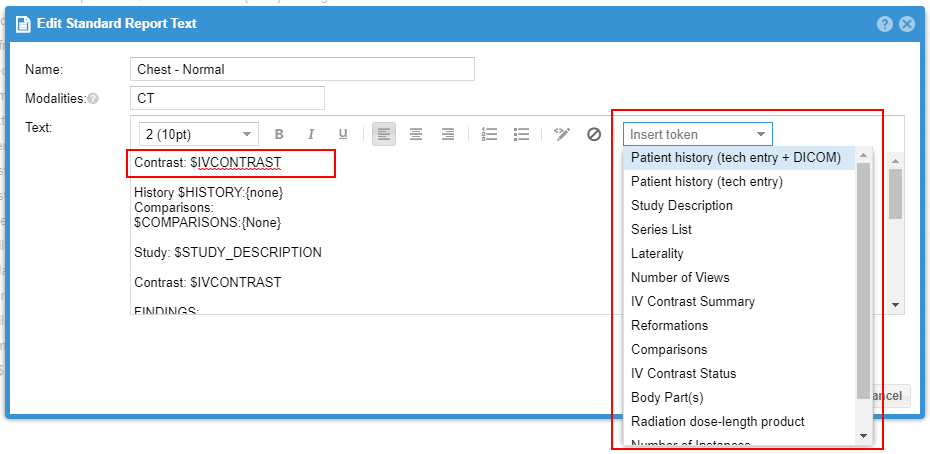Report editor tokens can be inserted into the report editor window by standard report text, copy/paste, or by the OnePacs Report Generator system. These tokens are evaluated in real-time to values specific to the subject study. For example, the “Patient History” token would be substituted with the actual patient history captured during the confirmation process. They should not be confused with report template tokens which are used to format the general layout of a report while report template tokens would generally end up translated in the report body. Some report editor tokens and report template tokens overlap.
Below, is an example of a report editor token used with a standard report text. $IVCONTRAST is defined to be used for the standard.

When the token is inserted into a report (whether through typing, pasting, standard report texts, report generator templates, or other means), the token will be substituted with actual values for the study in question.
For example, when the token $IVCONTRAST is inserted into a report, OnePacs will replace "$IVCONTRAST" with the information that has been provided by the technologist regarding IV contrast during study confirmation, or with information that may be available in relevant DICOM headers if the IV contrast status was not provided by the technologist.
For example, "$IVCONTRAST" may be replaced with "With; 100 mL Omnipaque", if such information was provided during study confirmation, or if it is available in relevant DICOM headers.
Individual Tokens
An individual token can also be inserted by using the button on the right side of the report editor when entering a report.
Default Values
If information is not available for a particular token, one may specify a default, or failover, value to be used instead.
For example, the $COMPARISONS token is populated with information based on which prior studies have been selected as comparison studies by the radiologist at the time of study interpretation. If the radiologist has not selected any studies, it may be desirable for this token to be replaced with text such as "No prior studies for comparison."
The syntax for the inserted text in this case is:
$TOKEN:{Default value}
That is,
Comparisons: $COMPARISONS:{No comparison study available.}
Would resolve to a list of the study(ies) with which an examination is being compared if such information is available:
Comparisons: MR\OT - MR WRIST LEFT - 07/19/2013 03:59 PM EDT
or will fail over to "No comparison study available." if no comparison study information has been selected:
Comparisons: No comparison study.
Tokens Available for use in the OnePacs Report Edit window
| Token | Description |
|---|---|
| $COMPARISONS | Comparison studies for the current study |
| $HISTORY | History inputted by the technologist for the case during study confirmation |
| $IVCONTRAST | Information regarding whether IV contrast was administered, and if so, type and dosage |
| $LATERALITY | The study laterality |
| $NUMVIEWS | The number of views for an XRAY study |
$PATIENT_HISTORY | All available history information, including technologist-entered history (the $HISTORY token) as well as any history available in DICOM |
| $REFORMATIONS | A list of reformations entered by the technologist |
| $SERIESLIST | A list of all series within a study |
$STUDY_DESCRIPTION | The study description provided in the DICOM data |
| $DLP | Radiation Dose-length product information, in mGy•cm, if entered by the technologist during study confirmation |
 Use of Specific Tokens
Use of Specific Tokens
The $COMPARISONS token will resolve to a list of comparison study(ies) selected by a radiologist as comparison studies at the time of study interpretation.
This is done by toggling the "comparison" folder icon in the study history list in the report edit window.
Many Report Generator templates for OnePacs make use of the $COMPARISONS token, so if comparison studies are selected prior to editing the report in the Report Generator GUI, or through auto-mode, the comparison study information will be inserted into the report.

